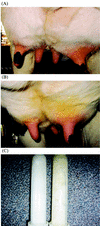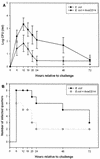Recombinant soluble CD14 reduces severity of intramammary infection by Escherichia coli
- PMID: 12819092
- PMCID: PMC161972
- DOI: 10.1128/IAI.71.7.4034-4039.2003
Recombinant soluble CD14 reduces severity of intramammary infection by Escherichia coli
Abstract
The interaction among gram-negative bacteria, the innate immune system, and soluble CD14 (sCD14) has not been well documented. The effect of recombinant bovine sCD14 (rbosCD14) on milk somatic cell count (SCC), bacterial clearance, and cytokine production was investigated by using a bovine intramammary Escherichia coli infection model. We first determined whether rbosCD14 would increase the SCC during a lipopolysaccharide (LPS) challenge. Three quarters of each of six healthy lactating cows were injected with either 0.3 microg of LPS, 0.3 microg of LPS plus 100 micro g of rbosCD14, or saline. In comparison with quarters injected with LPS alone, the SCC was twofold higher (P < 0.05) in quarters injected with LPS plus rbosCD14 after the challenge. We therefore hypothesized that when E. coli bacteria invade the mammary gland, sCD14 in milk would interact with LPS and rapidly recruit neutrophils from the blood to eliminate the bacteria before establishment of infection. To test this hypothesis, two quarters of each of nine healthy cows were challenged with either 50 CFU of E. coli plus saline or 50 CFU of E. coli plus 100 microg of rbosCD14. Quarters challenged with E. coli plus rbosCD14 had a more rapid recruitment of neutrophils, which was accompanied by a faster clearance of bacteria, lower concentrations of tumor necrosis factor alpha and interleukin-8 in milk, and milder clinical symptoms, than challenged quarters injected with saline. Results indicate that increasing the concentration of sCD14 in milk may be a potential strategy with which to prevent or reduce the severity of infection by coliform bacteria.
Figures





Similar articles
-
Recombinant bovine soluble CD14 reduces severity of experimental Escherichia coli mastitis in mice.Vet Res. 2003 May-Jun;34(3):307-16. doi: 10.1051/vetres:2003006. Vet Res. 2003. PMID: 12791240
-
Recombinant bovine soluble CD14 sensitizes the mammary gland to lipopolysaccharide.Vet Immunol Immunopathol. 2002 May;86(1-2):115-24. doi: 10.1016/s0165-2427(02)00021-1. Vet Immunol Immunopathol. 2002. PMID: 11943334
-
Elevated milk soluble CD14 in bovine mammary glands challenged with Escherichia coli lipopolysaccharide.J Dairy Sci. 2003 Jul;86(7):2382-9. doi: 10.3168/jds.S0022-0302(03)73832-6. J Dairy Sci. 2003. PMID: 12906056
-
Increase of Escherichia coli inoculum doses induces faster innate immune response in primiparous cows.J Dairy Sci. 2004 Dec;87(12):4132-44. doi: 10.3168/jds.S0022-0302(04)73556-0. J Dairy Sci. 2004. PMID: 15545375
-
The bovine neutrophil: Structure and function in blood and milk.Vet Res. 2003 Sep-Oct;34(5):597-627. doi: 10.1051/vetres:2003024. Vet Res. 2003. PMID: 14556697 Review.
Cited by
-
Sensing of Escherichia coli and LPS by mammary epithelial cells is modulated by O-antigen chain and CD14.PLoS One. 2018 Aug 24;13(8):e0202664. doi: 10.1371/journal.pone.0202664. eCollection 2018. PLoS One. 2018. PMID: 30142177 Free PMC article.
-
Endotoxin and CD14 in the progression of biliary atresia.J Transl Med. 2010 Dec 21;8:138. doi: 10.1186/1479-5876-8-138. J Transl Med. 2010. PMID: 21172039 Free PMC article.
-
CD14 C-159T polymorphism and its association with chronic lung diseases: A pilot study on isocyanate exposed population of Central India.Indian J Hum Genet. 2013 Apr;19(2):188-95. doi: 10.4103/0971-6866.116124. Indian J Hum Genet. 2013. PMID: 24019621 Free PMC article.
-
Plant production of veterinary vaccines and therapeutics.Curr Top Microbiol Immunol. 2009;332:79-102. doi: 10.1007/978-3-540-70868-1_5. Curr Top Microbiol Immunol. 2009. PMID: 19401822 Free PMC article. Review.
-
Acute Escherichia coli mastitis in dairy cattle: diagnostic parameters associated with poor prognosis.J Vet Med Sci. 2014 Nov;76(11):1431-6. doi: 10.1292/jvms.13-0610. Epub 2014 Jul 24. J Vet Med Sci. 2014. PMID: 25056677 Free PMC article.
References
-
- Anderson, J. C. 1978. The effect of colonization of the mouse mammary gland by Staphylococcus epidermidis on subsequent infection with Staphylococcus aureus or Escherichia coli. J. Comp. Pathol. 88:545-553. - PubMed
-
- Bazil, V., V. Horejsi, M. Baudys, H. Kristofova, J. L. Strominger, W. Kostka, and I. Hilgert. 1986. Biochemical characterization of a soluble form of the 53-kDa monocyte surface antigen. Eur. J. Immunol. 16:1583-1589. - PubMed
-
- Bazil, V., and J. L. Strominger. 1991. Shedding as a mechanism of down-modulation of CD14 on stimulated human monocytes. J. Immunol. 147:1567-1574. - PubMed
-
- Bramley, A. J. 1976. Variation in the susceptibility of lactating and non-lactating bovine udders to infection when infused with Escherichia coli. J. Dairy Sci. 79:3094-3103. - PubMed
-
- Burvenich, C., M. J. Paape, A. W. Hill, A. J. Guidry, R. H. Miller, R. Heyneman, W. D. Kremer, and A. Brand. 1994. Role of the neutrophil leukocyte in the local and systemic reactions during experimentally induced E. coli mastitis in cows immediately after calving. Vet. Q. 16:45-50. - PubMed
Publication types
MeSH terms
Substances
LinkOut - more resources
Full Text Sources
Medical
Research Materials

